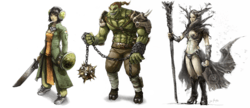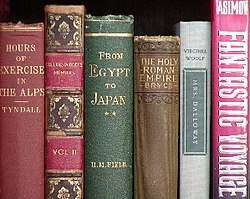High fantasy
High fantasy or epic fantasy is a subgenre of fantasy,[1] defined either by the epic nature of its setting or by the epic stature of its characters, themes, or plot.[2] The term "high fantasy" was coined by Lloyd Alexander in a 1971 essay, "High Fantasy and Heroic Romance" (originally given at the New England Round Table of Children's Librarians in October 1969).[2]
| Fantasy |
|---|
 |
| Media |
|
| Genre studies |
| Subgenres |
|
| Fandom |
| Categories |
|
|
| Literature |
|---|
|
| List of high fantasy fiction |
Characteristics
High fantasy is set in an alternative, fictional ("secondary") world, rather than the "real" or "primary" world.[2] This secondary world is usually internally consistent, but its rules differ from those of the primary world. By contrast, low fantasy is characterized by being set in earth, the primary or real world, or a rational and familiar fictional world with the inclusion of magical elements.[3][4][5][6]
The romances of William Morris, such as The Well at the World's End, set in an imaginary medieval world, are sometimes regarded as the first examples of high fantasy.[7] The works of J. R. R. Tolkien—especially The Lord of the Rings—are regarded as archetypal works of high fantasy.[7] Also, Lloyd Alexander's The Chronicles of Prydain, Stephen R. Donaldson's The Chronicles of Thomas Covenant[8] and David Eddings' The Belgariad are good examples of a high fantasy series.
Many high fantasy stories are told from the viewpoint of one main hero. Often, much of the plot revolves around their heritage or mysterious nature. In many novels the hero is an orphan or unusual sibling, often with an extraordinary talent for magic or combat. They begin the story young, if not as an actual child.[9] In other works the hero is a completely developed individual with a unique character and spirit.
The hero often begins as a childlike figure, but matures rapidly, experiencing a considerable gain in fighting/problem-solving abilities along the way.[10] The plot of the story often depicts the hero's fight against the evil forces as a bildungsroman.
The progress of the story leads to the character's learning the nature of the unknown forces against them, that they constitute a force with great power and malevolence.[11]
Themes
Good versus evil is a common theme in high fantasy, and the character of evil is often an important theme in a work of high fantasy,[12] as in The Lord of the Rings. Indeed, the importance of the concepts of good and evil can be regarded as the distinguishing mark between high fantasy and sword and sorcery.[13] In many works of high fantasy, this conflict marks a deep concern with moral issues; in other works, the conflict is a power struggle, with, for instance, wizards behaving irresponsibly whether they are "good" or "evil".[14]
There is often some evil that must be defeated, sometimes, a mysterious Dark Lord, often obsessed with taking over the world and killing the main hero. The evil character is sometimes an evil wizard or sorcerer, or sometimes a kind of god or demon. The antagonist usually commands a large army or a group of highly feared servants, and the protagonists appear outmatched.
Game settings
Role-playing games such as Dungeons & Dragons with campaign settings like Greyhawk by Gary Gygax, Dragonlance[15] by Tracy Hickman and Margaret Weis and Forgotten Realms by Ed Greenwood[16] are a common basis for many fantasy books and many other authors continue to contribute to the settings.[17]
See also

- Eric Rücker Eddison was a pre-Tolkien high fantasy writer
- Heroic fantasy
- Historical fantasy
- List of genres
- List of high fantasy fiction
- Low fantasy
- Medieval fantasy
- Sword and sorcery
References
- "Defining the Genre: High Fantasy". fandomania. 11 May 2011. Retrieved 8 August 2016.
High Fantasy is probably one of the most recognizable subgenres of Fantasy.
- Brian Stableford, The A to Z of Fantasy Literature, (p. 198), Scarecrow Press, Plymouth. 2005. ISBN 0-8108-6829-6
- Buss, Kathleen; Karnowski, Lee (2000). Reading and Writing Literary Genres. International Reading Assoc. p. 114. ISBN 978-0-87207-257-2.
- Perry, Phyllis Jean (2003). Teaching Fantasy Novels. Libraries Unlimited. p. vi. ISBN 978-1-56308-987-9.
- Gamble, Nikki; Yates, Sally (2008). Exploring Children's Literature. SAGE Publications Ltd. pp. 102–103. ISBN 978-1-4129-3013-0.
- C.W. Sullivan has a slightly more complex definition in "High Fantasy", chapter 24 of the International Companion Encyclopedia of Children's Literature by Peter Hunt and Sheila G. Bannister Ray (Routledge, 1996 and 2004), chapter 24.
- Dozois, Gardner (1997). "Preface". Modern Classics of Fantasy. New York: St. Martin's Press. pp. xvi-xvii. ISBN 031215173X.
- Gunn, James E. (2013). Paratexts: Introductions to science fiction and fantasy. Lanham: The Scarecrow Press, Inc. p. 123. ISBN 9780810891227.
Stephen R. Donaldson's Lord Foul's Bane is a High Fantasy that is often compared with Tolkien's Lord of the Rings ... but Donaldson's approach to his Secondary World, the Land, differs in remarkable ways
- Michael Moorcock. Wizardry & Wild Romance: A Study of Epic Fantasy. p. 84. ISBN 1-932265-07-4.
- Casey Lieb, "Unlikely Heroes and their role in Fantasy Literature"
- Patricia A. McKillip, "Writing High Fantasy", p 53, Philip Martin, ed., The Writer's Guide to Fantasy Literature: From Dragon's Lair to Hero's Quest, ISBN 0-87116-195-8
- Tom Shippey, J.R.R. Tolkien: Author of the Century, p 120, ISBN 0-618-25759-4
- Joseph A. McCullough V, "The Demarcation of Sword and Sorcery"
- Ursula K. Le Guin, "The Question I Get Asked Most Often" p 274, The Wave in the Mind, ISBN 1-59030-006-8
- "Dragonlance homepage". Archived from the original on 4 March 2006. Retrieved 2 March 2006.
- Snow, Cason (2008). "Dragons in the stacks: an introduction to role-playing games and their value to libraries". Collection Building. 27 (2): 63–70. doi:10.1108/01604950810870218.
For Dungeons and Dragons, both TSR and WotC produced additional settings that can be used with the core rules, two of the most popular being the magic-punk Eberron ... and the high fantasy Forgotten Realms Campaign Setting.
- "Most role-playing games draw upon a universe based in high fantasy; this literary genre, half-way between traditional fantasy ..." Squedin, S., & Papillon, S. (2008). U.S. Patent Application 12/198,391.
External links
- "Fantasy Genre Lecture"—A paper by Michael Joseph discussing high fantasy and referencing Alexander's theories, via Rutgers' School of Communication and Information.
- "The Flat-Heeled Muse" by Lloyd Alexander, the inventor of the term "high fantasy", discusses fantasy worldbuilding and "the problems and disciplines of fantasy"
- "Fantasy book writing: 7 tips"—Now Novel discusses the origin of the term, referencing Lloyd Alexander and offering high fantasy writing tips